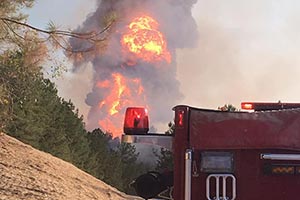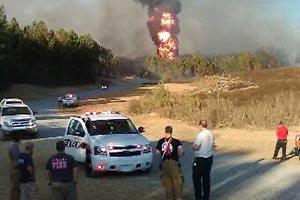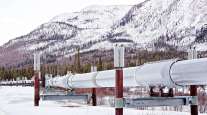What Happens When the Most Important Pipeline in the US Explodes?

On Oct. 31, a construction crew in Alabama triggered a massive explosion when a track-hoe struck the biggest fuel pipeline in the United States. The blast killed one person, injured several and sparked a wildfire that burned for nearly a day across 31 acres.
It also stopped the flow of millions of gallons of gasoline that move up the East Coast each day, from refineries in Houston to tanks in Linden, N.J., outside New York Harbor. The Colonial Pipeline consists of two lines — one that carries gasoline and the other pipe that carries distillate fuels such as diesel and jet fuel. Think of it as the country’s fuel aorta.
RELATED: Gasoline jumps most since 2008 after pipeline blast
The consortium that owns Colonial includes private equity behemoth KKR, industrial conglomerate Koch Industries, and oil-and-gas supermajor Royal Dutch Shell. The fact that it’s so little known, yet such a vital piece of infrastructure, is a testament to how well Colonial has been run over the years.
But this is its second outage in two months. In September, a spill leaked 250,000 gallons of gasoline and caused states of emergency to be declared in Georgia and Alabama as gasoline ran out in some areas. The Colonial was down for 12 days.
The United States has plenty of gasoline in storage. Tanks are brimming with near-record levels of supply. But that was true in September as well, when the outage caused all kinds of disruptions and price spikes.
“All that supply does you absolutely no good if you can’t move it around,” said Phil Flynn, a senior market analyst with the Price Futures Group in Chicago.
 Alabaster (Ala.) Fire Department/Facebook
Alabaster (Ala.) Fire Department/FacebookBy the morning of Nov. 1, Colonial’s Line 2, the distillate pipe, was up and running. By the afternoon of Nov. 1, news broke that its main line, Line 1, would be back up by the afternoon of Nov. 5, an optimistic timetable, according to some traders, given the level of destruction at the site. Still, the news helped cool the initial spike in the price of gasoline futures, which had jumped the most since 2008, fueled by a record level of trading that day.
Traders in Houston working for big refineries have had to find a place to put all the excess barrels of gasoline and diesel they normally would send into the Colonial. That has set off a bidding war for the limited number of tankers and barges available to move products between U.S. ports. An obscure maritime law called the Jones Act requires that only U.S.-made, U.S.-flagged ships can deliver goods between ports. According to Bloomberg News vessel-tracking data, about 27 Jones Act vessels were in service around the U.S. Gulf and the East coasts as of the morning of Nov. 3.
Shipowners have been able to about double the price they charge to lease their tankers and barges, said Court Smith, a research analyst at MJLF & Associates, a shipping brokerage in Connecticut. Depending on how long the outage lasts, the federal government could waive the Jones Act, as it did after Hurricane Sandy in 2012, to alleviate fuel shortages in the Northeast.
Traders who can’t get their hands on Jones Act ships will have to find tanks on land. Floating storage also has become a thing, where people lease ships to store their product. Refiners along the Gulf can also start changing the slate of products they make. The worst option for them is to throttle back and produce less, which would eat into their profits.
If it’s anything like the September outage, a fleet of vessels bringing imported gasoline will start heading to the U.S. East Coast, where they probably can fetch higher prices. During the second half of September, gasoline imports to the East Coast jumped to 800,000 barrels a day from about 500,000 barrels a day.
One vessel, the Flagship Violet, made its way from India eventually to New York Harbor. It never unloaded and has been sitting outside the harbor ever since, laden with 500,000 barrels of alkalyte, a distillate used to raise the octane in gasoline, according to data from ClipperData, a petroleum market research firm. On Nov. 1, the vessel changed its destination for the first time in a month, to a location within New York Harbor.
The outage is good news for refineries on the East Coast that can take those imported barrels.
“The clear winners here are the Philadelphia-area refiners,” said John Mayes, director of special studies at Turner Mason, an energy consulting firm in Dallas. Shares of PBF Energy, which owns a large refinery outside Wilmington, Delaware, spiked Nov. 1 by 12% in early trading, though they since have come down.
Given the assurances from Colonial and what so far has been a more muted market response, some participants think the outage will be less severe than the one in September, when gas stations in Alabama and Georgia ran out of fuel. “We’re not going to see pumps getting bagged,” said Ernie Barsamian, a principal at the Tank Tiger, a tank-storage broker in New Jersey.
The September outage prompted a cannonball run as tanker trucks raced to deliver gasoline from the Midwest to the Southeast. “You saw trucks driving all night from Indiana, Illinois and Ohio, down to Alabama and Georgia,” said Tom Kloza, chief analyst at the Oil Price Information Service. Although the outage is supposed to be contained by Nov. 5, Kloza expects the effects to be similar to what happened in September.
No matter how long it lasts, the Colonial outage probably will lead to higher gasoline prices in the days leading up to the presidential election in states such as Tennessee, Georgia and the Carolinas. Normally, spiking prices at the pump as Americans go to the polls could spell trouble for the incumbent party. But the effects likely will be smaller, given how cheap gasoline has been over the past two years.
“I think gasoline prices on Election Day will be 15 cents to 20 cents higher than they were last year,” Kloza said. “But let’s remember, that’s still $1.35 lower than they were in 2012.”




